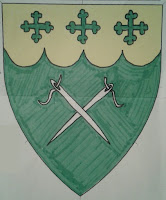I have been contemplating bags, fabric sacks for carrying whatever needs to be brought along. There is, of course, the 1170 German bag I will be reproducing when I understand the techniques involved. Then there's something Ose told me, that when Baron Master George Emerson True was learning different stitches, he would practice them by making bags to hide his wallet, phone, and other modern devices he wanted to disguise. Sewing bags also allowed him to work on something small and unobtrusive during court.
I was at the coronation of Brennan II and Caoilfhion II this past Saturday. As we all know, Coronation is ALL court. I gathered material, thread needles, scissors, etc. and started a bag during morning court. The German bag is approximately 3" x 5" and this first bag is quadruple the size at 6" x 10", big enough to hold my fast-acting inhaler and tube. I used brown linen, modern thread for the seams and bottom hem and Pearl Cotton for the trim and decorative stitches.
Construction proceeded thus:
- Pulled threads to straighten edges of material, keeping the selvage on one long side.
- Folded along short edge to create a piece half the original width and the same length as before.
- Sewed the seam with a running stitch using the modern thread, right sides together.
- Finger-pressed seam allowance (1/2") open.
- Turned right side out on itself so that one opening has a folded edge and the other has four raw edges. The folded edge is the top, the other the bottom. The bottom edges I folded in to encase the raw edges.
- While both ends were still open, sewed on a length of monks cord made with #5 Pearl Cotton
- Overcast the folded bottom edges with #8 Pearl Cotton (see above). (I'm left-handed, hence the backwards look to my stitches for most of you.)
- Used a stab stitch because of the number of layers (8) to make a strong bottom seam to the bag, going one direction then doubling back to fill in the stitches on the other side. (see below) This seems to be how the German bag is made.
- Lastly, overcast the folded edge at the top with #8 Pearl Cotton.
The monk's cording for the drawstrings is made and waiting for me to test my theory on how the German bag was closed...
~ Marjorie





 Jenny making her caterpillar. She's excited about having something to do while recovering from ankle surgery.
Jenny making her caterpillar. She's excited about having something to do while recovering from ankle surgery.









